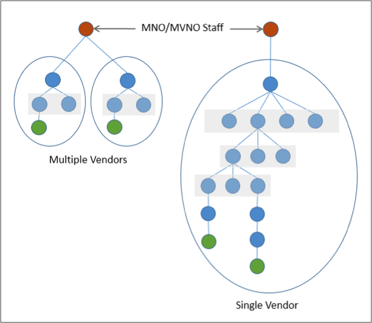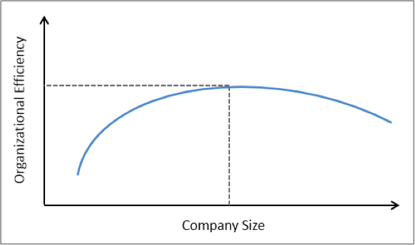New mobile technologies are evolving at an accelerating pace, putting pressure on MNOs and MVNOs to find innovative ways to cost-effectively offer new services to their customers. In some ways, it is a paradigm shift for mobile operators. At one time, MNOs could base their business plans on offering a limited set of services that included voice and eventually text messaging. In that era, the principal competitive imperative was to build the largest network, with the largest geographical coverage, and with the best Quality of Service (QoS).
With a limited set of service offerings, there was little pressure for MNOs to consider whether using multiple vendors was better than using just a single vendor. But now, the pressure to quickly offer new and diverse services means that MNOs must reevaluate the single vendor strategy that had previously served them well.
The precedent for multiple vendors
The question of whether it is better to have a single vendor or multiple vendors for technology is not unique to the mobile industry, nor is it a new topic of discussion. Information Technology (IT) professionals have been considering this question for some time, and we have seen the development of multi-vendor management platforms such as Service Integration and Management (SIAM)1. Although there are advocates for both approaches, a recent article by Bain and Company noted, “Given the rapid, ongoing innovation in IT services, the multi-source approach to managing IT is likely here to stay. It’s a smarter and more flexible model, with many advantages.”2
While the IT industry’s subject matter expertise and extensive analysis in this area can have relevancy to MNOs, it is beyond the scope of this article to delve too deeply into the previous literature on this subject. Instead, augmenting the concepts from a 2014 article by Gartner VP Andrew Butler3, the key distinctions between a single and multi-vendor are summarized below.
Multiple vendor considerations
- Better price negotiation power due to competition among vendors.
- Better support because the customer is not “locked in.”
- More technology choices and ability to choose the “best of breed.” A Capgemini report noted, “The current status quo dictates that services are delivered as discrete service elements, or ‘towers’, with each functioning as a single service. Increasingly, businesses are using service integration to create a ‘best-of-breed’ set of capabilities within a multi-sourcing environment, for transparency of services and for increased supplier control.”4 This point is especially important to MNOs and MVNOs as the demand for new services outpaces the ability of any one vendor to supply them all.
- Better opportunity for risk mitigation because there is not a single point of failure in the vendor supply chain. For MNOs and MVNOs, risk can be further mitigated by deploying third-party, cloud-based services that have high scalability and pay-as-you-grow pricing models.
Single vendor considerations
Possibility of simplified administration. Although this is a possible benefit, there is also the risk that the organizational infrastructure of a single vendor may be less efficient than a smaller organization. Larger organizations may be aware of the need for an efficient managerial span of control5, but as they grow in size, even well-intentioned organizations may ultimately suffer from organizational diseconomies of scale.6

Figure 1. Conceptualization of the impact of span of control on operational efficiency. Notice that a larger, single vendor is likely to have a more hierarchical organization structure than a smaller vendor. The gray rectangles in the diagram represent the span of control for each manager, while the green circles represent the individual responsible for fulfilling a request from the MNO or MVNO. The closer the customer is to the person fulfilling the request, the more efficient the response may be.

Figure 2. Conceptual representation of organizational diseconomies of scale. As organizations increase in size, they initially realize an improvement in operating efficiency. At some point, an organization may lose efficiency as the complexity of managing staff and operations becomes burdensome.
- Possibility of better interoperability of systems. However, this may be less of an issue for MNOs and MVNOs that focus on deploying solutions based on industry-recognized standards.
- Possibility of volume-based sales discounts.
- Potential of greater leverage due to limited points of contact with the vendor in what is known colloquially as a “single throat to choke.” However, this could alternatively be viewed as a single point of failure in the customer-vendor communication channel.
Why should MNOs and MVNOs embrace a multi-vendor approach?
The IT industry has established that there are distinct advantages to using multiple vendors, and many of those same advantages are directly applicable to MNOs and MVNOs. Beyond those common advantages, the mobile industry has additional incentives to consider using multiple vendors.
First among those incentives is that it will be increasingly difficult to meet escalating customer demand with a single vendor—the industry is simply moving too quickly. Another incentive is that third-party, cloud-based mobile solutions are becoming increasingly common. A third-party cloud solution such as Voice Over WiFi (VoWiFi) or Voice Over Data Channel (VoDC) allows MNOs and MVNOs to deploy the service quickly while minimizing the financial risk. A third-party cloud service means the MNO or MVNO does not have to develop the service in house, does not need to augment their technical staff, and are not committed to additional CAPEX.
In their recent white paper7 , BAE Systems summarized the challenge facing technology providers and noted the role of the cloud: “Government and commercial organisations are striving to deliver increasingly flexible and agile ICT whilst working in a heavily cost constrained environment. It’s a major challenge. And sights are increasingly focused on realising the benefits from multi-sourced ICT—working with a range of best of breed service providers rather than with one major systems integrator and sourcing capabilities from the Cloud, where appropriate.”
There is no single, right answer—just more options than ever before
Few decisions are simple, binary choices, and such is the case when deciding on a single or multi-vendor strategy. For MNOs and MVNOs, additional complexity is introduced into the decision process by the sheer number of options for cloud-based services from third-party vendors. However, there are a few key criteria to consider that may facilitate arriving at the optimal decision.
Part of the calculus in evaluating the range of third-party cloud providers is to determine if the solution is fully standards-based, or if it requires any proprietary components. For example, some solutions promoted as WiFi Calling require the download of a proprietary client on the device, while other solutions use embedded manufacturer functions. Another factor to consider is the nature of the cloud platform in terms of reliability and availability. Not all Network Operation Centers (NOCs) are created or managed equally, so exercising due diligence in evaluating the NOCs is prudent. Finally, given the proliferation of cloud service providers, it is pertinent to ascertain the experience and reputation of the vendor in the telecom industry.
Then there is the intangible factor to consider. Given the critical importance of outsourcing key services, MNOs and MVNOs would be well-served to strive to form a relationship with a vendor with whom they can form a true partnership, and not necessarily the one with the lowest fees.
In order for MNOs and MVNOs to keep pace with the new mobile technologies and remain relevant, they must consider the benefits of using a multiple vendor solution strategy.




